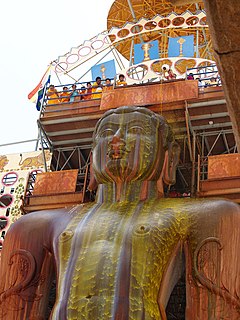
Summary
The Mahamastakabhisheka ("Grand Consecration") refers to the abhiṣeka (anointment) of the Jain idols when held on a large scale. The most famous of such consecrations is the anointment of the Bahubali Gommateshwara statue located at Shravanabelagola in Karnataka, India. It is an important Jain festival held once every 12 years. It is an integral part of the ancient and composite Jain tradition.
| Mahamastakabhisheka | |
|---|---|
 Anointing of the Gommateshwara statue in 2006 | |
| Also called | Translation: Head Anointing of Gommateshwara |
| Observed by | Jains |
| Type | Religious |
| Significance | Completion of the statue of Gommateshwara statue |
| Celebrations | Anointing the statue of Gommateshwara with milk, saffron, sugarcane juice, sandal paste, rice flour , flowers etc. |
| Observances | Prayers, Jain rituals |
| Date | Decided by the luni-solar Jain calendar |
| Frequency | every 12 years |

The festival is held in veneration of a 17.4-metre (57 ft) high monolithic statue of the Siddha Bahubali. The anointing last took place in February 2018, and the next ceremony will take place in 2030.[1] The ceremony in 2018 is said to be the 88th in the series that commenced in the year 981 AD and was the second Mahamastakabhisheka of the 21st century. The ceremony is expected to be graced by numerous Jain ascetics. The February 2018 event was held under the leadership of Charukeerthi Bhattaraka Swamiji of Shravanabelagola from 17 to 25 February 2018.[2]
Anointment of the Gommateshwara Bahubali image edit
Bahubali, the son of Rishabhanatha, the first of the twenty-four Jain Tirthankaras, is worshipped for living with exceptional qualities that he displayed during all stages of his life from conception, birth, renunciation, enlightenment and salvation. This 58.8 feet tall statue is the most magnificent among all Jain works of art. It was built in circa 983.[3] The Bahubali statue is described as one of the mightiest achievements of ancient Karnataka in the realm of sculptural art. The statue stands upright in the posture of meditation known as kayotsarga, reaching a height of nearly 57 feet atop the Vindhyagiri Hills - accessible through a flight of 700 steps.[4]
Procedure edit
Purified water and sandalwood paste is poured over the statue from a scaffolding. This event continues for weeks. As the Mahamastakabhisheka begins, consecrated water is sprinkled onto the participants by devotees carrying 1,008 specially prepared vessels (kalashas). The statue is then bathed and anointed with libations such as milk, sugarcane juice, and saffron paste, and sprinkled with powders of sandalwood, turmeric, and vermilion.[5] Offerings are made of petals, gold and silver coins, and precious stones. Most recently, the ceremony's finale has included an enormous shower of flowers from a waiting helicopter.[6]
Other Mahamastakabhishekas edit
Apart from the anointment of the Gommateshwara statue at Shravana Belgola, anointment of the Jaina images take place at Jain temples throughout India.[7] Anointment of the other Gommateshwara statues in Karnataka are also honoured with a Mahamastakabhisheka festival every 12 years.[citation needed]
- Dharmasthala Mahamastakabhisheka[citation needed]
- Karkala Mahamastakabhisheka - The last Mahamastakabhisheka was held in February 2002, and the next will be in 2015.[8][better source needed]
- Venur Mahamastakabhisheka - The last one was from 28 January 2012 to 5 February 2012. The next one will be in 2024.[9][better source needed]
- Kumbhoj Mahamastakabhisheka - The last Mahamastakabhisheka was held in 2015, and the next will be in 2027.[citation needed]
See also edit
References edit
Citations edit
- ^ Correspondent, TNN (8 February 2006). "Mahamastakabhisheka of Bahubali begins today". The Times of India. Archived from the original on 26 January 2013. Retrieved 19 December 2012.
- ^ Staff Reporter (13 October 2016), "Dates for Mahamastabhisheka at Shravanabelagola announced", The Hindu, retrieved 26 February 2018
- ^ Zimmer 1953, p. 212.
- ^ Muni Kshamāsāgara 2006, p. 49.
- ^ Kumar, Brajesh (2003), Pilgrimage Centres of India, Diamond Pocket Books (P) Ltd., p. 199, ISBN 9788171821853
- ^ Sangave, p. 106.
- ^ Drivedi, Rakesh Narayan. राही मासूम रज़ा और उनके औपन्याससक पात्र. p. 65.
- ^ "Karkala Mahamastakabhisheka 2014".
- ^ "Venur Mahamastakabhisheka 2012". Archived from the original on 18 February 2013. Retrieved 27 January 2012.
Sources edit
- Jaini, Padmanabh S. (1998) [1979], The Jaina Path of Purification, Delhi: Motilal Banarsidass, ISBN 978-81-208-1578-0
- Zimmer, Heinrich (1953) [April 1952]. Campbell, Joseph (ed.). Philosophies Of India. London: Routledge & Kegan Paul Ltd. ISBN 978-81-208-0739-6.
- Rice, Lewis (1985). Naga Varmma's Karnataka Bhasha Bhushana. Asian Educational Services. ISBN 9788120600621.
- Rice, B. L. (2001), Gazetteer of Mysore, Asian Educational Services, ISBN 9788120609778
- Sangave, Vilas Adinath (1981), The Sacred Sravana-Belagola, Bhartiya Jnanpith Prakash, retrieved 16 November 2017
- Kshamāsāgara, Muni (2006), In quest of the self, Bhartiya Jnanpith, ISBN 9788126311668, retrieved 16 November 2017
External links edit
- Mahamasthakabhisheka Bahubali Official Website
- BBC News Special: Interview and Photo Reportage


